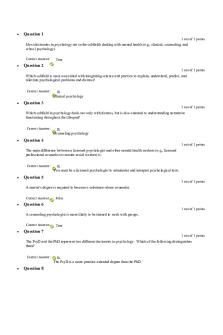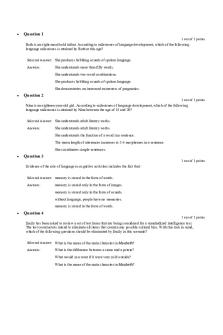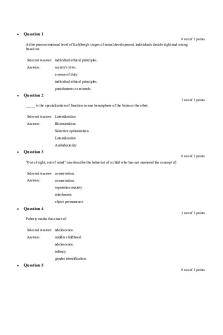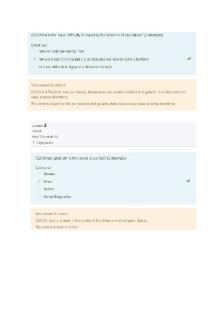Quiz 2 - Weekly Quiz PDF

| Title | Quiz 2 - Weekly Quiz |
|---|---|
| Author | Skyler Ballesteros |
| Course | Gen Psychology |
| Institution | Indiana State University |
| Pages | 6 |
| File Size | 95 KB |
| File Type | |
| Total Downloads | 62 |
| Total Views | 154 |
Summary
Weekly Quiz...
Description
Question 1 1 out of 1 points
In descriptive statistics, the three measures of central tendency are: Selected Answer: mean, median, and mode. Answers:
mean, median, and mode. mean, variance, and standard deviation. range, variance, and standard deviation. correlation, regression, and variance.
Question 2 1 out of 1 points
_____ is a measure of dispersion that indicates how much scores in a sample vary around the mean of the sample. Selected Answer: Standard deviation Answers:
Correlation coefficient Median Range Standard deviation
Question 3 1 out of 1 points
In the context of evaluating theories in psychology, _____ is a method that allows researchers to combine the results of several studies on a similar topic in order to establish the strength of an effect. Selected Answer: meta-analysis Answers:
meta-analysis replication substantiation verification
Question 4 1 out of 1 points
Which of the following features of an experiment does not typically lead to biased results? Selected Answer: Random assignment Answers:
Confound variables Random assignment Demand characteristics Experimenter bias
Question 5
1 out of 1 points
In the context of the correlational method of study, the "third variable problem" refers to a: Selected Answer: situation where a variable that is not measured actually accounts for the relationship. Answers:
study in which an independent variable is not manipulated. study in which the results reveal a zero correlation. situation where a variable that is not measured actually accounts for the relationship. situation where the proper dependent variable is not measured.
Question 6 1 out of 1 points
In terms of statistical significance, what is considered to be the minimum level of probability that scientists will accept for concluding that observed differences are real and not due to chance? Selected Answer: .05 Answers:
.001 .05 .95 .99
Question 7 1 out of 1 points
In descriptive statistics, the _____ is determined by adding up participants' scores and dividing by the number of scores. Selected Answer: mean Answers:
median standard deviation correlation coefficient mean
Question 8 1 out of 1 points
In the context of experimental research, random assignment of participants is important in order to ensure that: Selected Answer: groups have equal and balanced composition. Answers:
independent variables are not restricted. groups have equal and balanced composition. genders and ages are viewed independently. all participants that have specific characteristics are viewed in a single group.
Question 9 1 out of 1 points
Professor Jordan has suggested to his students that a strong relationship exists between the number of hours they spend studying and their grade on the final exam. He would like his students to improve their test scores by increasing the time they spend studying. The professor is describing a: Selected Answer: positive correlation. Answers:
mean score. negative correlation. positive correlation. standard deviation.
Question 10 0 out of 1 points
Liam, a psychology teacher, designs a questionnaire to determine the most preferred social media among students in his classroom. Which measure of central tendency should he use to get an accurate idea? Selected Answer: Mean Answers:
Range Mode Median Mean
Question 11 1 out of 1 points
Derek, an Internet activist, committed suicide. Investigators are exploring Derek's past interactions on Wordbook, a famous social networking site, to discover any information that might reveal the reasons behind his suicide. In this scenario, the research method used by the investigators is most likely the _____. Selected Answer: case study Answers:
case study interview survey experiment
Question 12 1 out of 1 points
In the context of psychology's scientific method, which of the following scenarios best represents an operational definition? Selected Answer:
Dr. Williams states that his subjects' manual dexterity can be assessed by the number of assigned manual tasks they are able to complete.
Answers:
Dr. Williams states that his subjects' manual dexterity can be assessed by the number of assigned manual tasks they are able to complete. Dr. Bowden determines the efficiency of the newest jets found in the Air Force.
Dr. Smith states that his students must recall their earliest childhood memories and use these to understand more about themselves. Dr. Benedict has his subjects go online to look up examples of "jealousy."
Question 13 1 out of 1 points
A psychological study indicates a strong positive correlation between two variables. This means that: Selected Answer: as one variable increases, the other also increases. Answers:
as one variable increases, the other decreases. the correlation coefficient is 0.00. one variable causes the other variable to occur. as one variable increases, the other also increases.
Question 14 0 out of 1 points
In the context of psychology's scientific method, which of the following is true of a theory? Selected Answer: A theory is an educated guess that derives logically from a hypothesis. Answers:
A theory explains relations between variables on a conceptual level. A theory is an educated guess that derives logically from a hypothesis. A theory cannot explain the occurrences of phenomena. A theory cannot be used to make predictions about future observations.
Question 15 1 out of 1 points
Surveys, case studies, and interviews are all a part of the psychological research method known as _____ research. Selected Answer: descriptive Answers:
experimental descriptive correlational developmental
Question 16 1 out of 1 points (Extra Credit)
A history class of 50 students has agreed to be the subject of a research study. Half of the class has been asked to study for the next history test while listening to classical music. The remaining half has been asked to study in a completely silent environment. The test scores of the two groups will be compared at the end of the experiment. In this experiment, which of the following is the dependent variable? Selected Answer: The test scores of both groups at the end of the experiment
Answers:
The classical music for the first half of the class The silent environment for the second half of the class The reading speed of both groups during the experiment The test scores of both groups at the end of the experiment
Question 17 1 out of 1 points
A team of psychology students would like to expose their classmates to an embarrassing experience in order to gather data for their term project. Their instructor has asked them to read the ethical guidelines published by the American Psychological Association (APA). She wants them to understand that, as researchers: Selected Answer:
they must obtain the consent of the participants after informing them of the procedures.
Answers:
they cannot ever engage in deception. they cannot conduct a study in which people will feel embarrassed. they must obtain the consent of the participants after informing them of the procedures. they must not let the participants know that they will be subject to embarrassing experiences.
Question 18 0 out of 1 points
When psychologists conduct a study, the group of participants chosen for the study is referred to as the: Selected Answer: population. Answers:
sample. study group. population. social group.
Question 19 1 out of 1 points
When psychological researchers use the correlational method to study variables, a correlation coefficient indicates the _____ between two variables. Selected Answer: degree of relationship Answers:
cause and effect relationship degree of relationship standard deviation validity
Question 20 1 out of 1 points
What does the magnitude of a correlation coefficient indicate about the variables in a correlational study?
Selected Answer: Strength of the relationship between the variables Answers:
Size of the variables Strength of the relationship between the variables Number of data points Direction of the relationship between the variables
Question 21 1 out of 1 points
In the context of psychological research methods, a(n) _____ presents a standard set of questions, or items, to obtain people's self-reported attitudes or beliefs about a particular topic. Selected Answer: survey Answers:
experiment case study observation survey...
Similar Free PDFs

QUIZ 2 - Weekly Quiz
- 2 Pages

Quiz 2 - Weekly Quiz
- 6 Pages

Quiz 8 - Weekly Quiz
- 6 Pages

Quiz 3 - Weekly Quiz
- 6 Pages

Quiz 5 - Weekly Quiz
- 6 Pages

Quiz 10 - Weekly Quiz
- 6 Pages

Quiz 9 - Weekly Quiz
- 6 Pages

BUS 335 Quiz 2 - Weekly Quiz
- 5 Pages

Chapter 12 Quiz - Weekly Quiz
- 3 Pages

Chapter 8 Quiz - Weekly Quiz
- 3 Pages

AP quiz+answers - Weekly quiz
- 1 Pages

Weekly Quiz 1 Solutions
- 3 Pages

Titas Weekly Quiz 5
- 2 Pages

Weekly Quiz Checkpoint
- 10 Pages

Quiz7 - Weekly quiz 7
- 1 Pages
Popular Institutions
- Tinajero National High School - Annex
- Politeknik Caltex Riau
- Yokohama City University
- SGT University
- University of Al-Qadisiyah
- Divine Word College of Vigan
- Techniek College Rotterdam
- Universidade de Santiago
- Universiti Teknologi MARA Cawangan Johor Kampus Pasir Gudang
- Poltekkes Kemenkes Yogyakarta
- Baguio City National High School
- Colegio san marcos
- preparatoria uno
- Centro de Bachillerato Tecnológico Industrial y de Servicios No. 107
- Dalian Maritime University
- Quang Trung Secondary School
- Colegio Tecnológico en Informática
- Corporación Regional de Educación Superior
- Grupo CEDVA
- Dar Al Uloom University
- Centro de Estudios Preuniversitarios de la Universidad Nacional de Ingeniería
- 上智大学
- Aakash International School, Nuna Majara
- San Felipe Neri Catholic School
- Kang Chiao International School - New Taipei City
- Misamis Occidental National High School
- Institución Educativa Escuela Normal Juan Ladrilleros
- Kolehiyo ng Pantukan
- Batanes State College
- Instituto Continental
- Sekolah Menengah Kejuruan Kesehatan Kaltara (Tarakan)
- Colegio de La Inmaculada Concepcion - Cebu
